maintenance MERCEDES-BENZ SPRINTER 2010 MY10 Operator’s Manual
[x] Cancel search | Manufacturer: MERCEDES-BENZ, Model Year: 2010, Model line: SPRINTER, Model: MERCEDES-BENZ SPRINTER 2010Pages: 292, PDF Size: 6.75 MB
Page 3 of 292
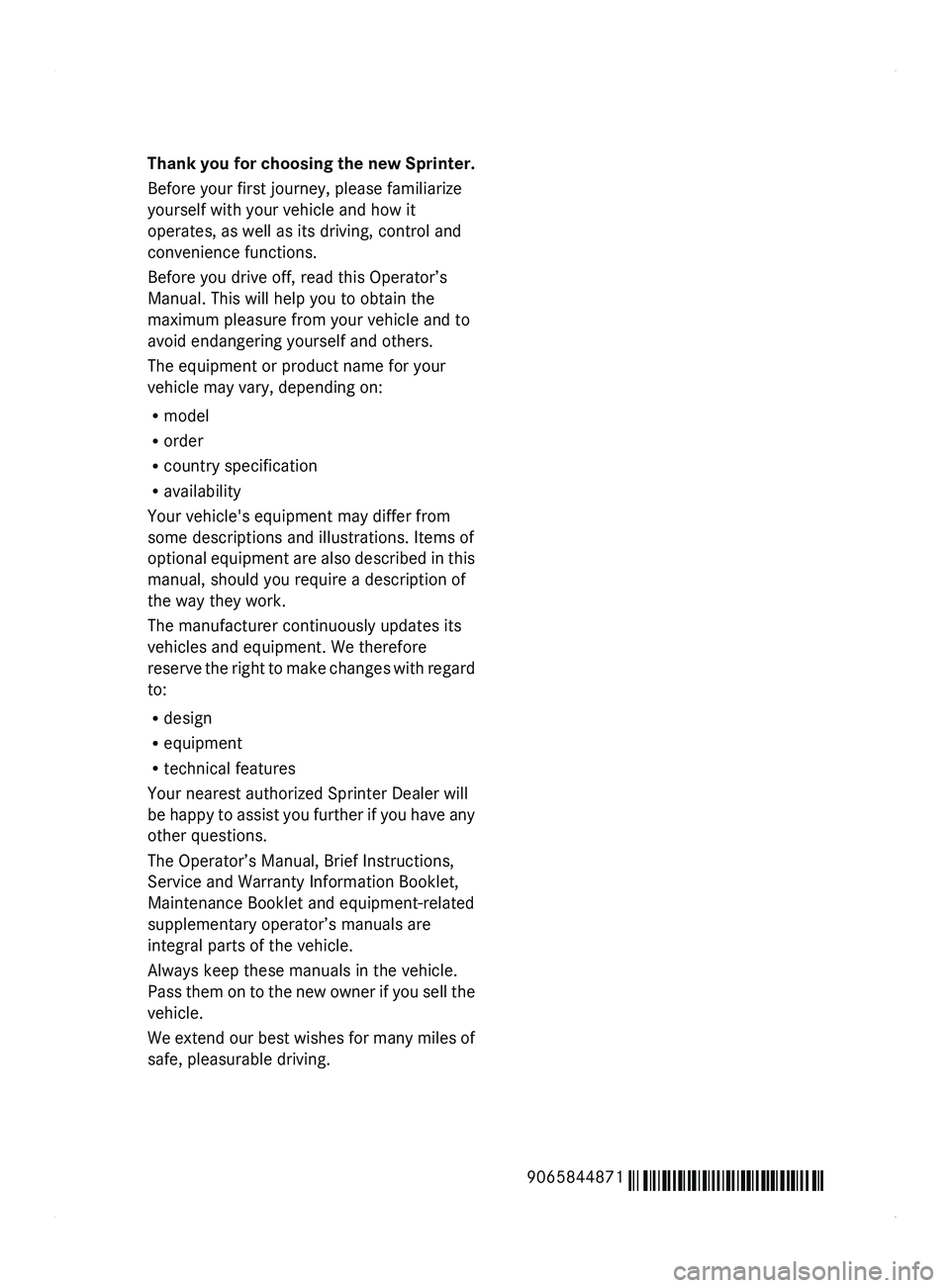
Thank you for choosing the new Sprinter.
Before your first journey, please familiarize
yourself with your vehicle and how it
operates, as well as its driving, control and
convenience functions.
Before you drive off, read this Operator’s
Manual. This will help you to obtain the
maximum pleasure from your vehicle and to
avoid endangering yourself and others.
The equipment or product name for your
vehicle may vary, depending on:
R
model
R order
R country specification
R availability
Your vehicle's equipment may differ from
some descriptions and illustrations. Items of
optional equipment are
also described in this
manual, should you require a description of
the way they work.
The manufacturer continuously updates its
vehicles and equipment. We therefore
reserve the right to make changes with regard
to:
R design
R equipment
R technical features
Your nearest authorized Sprinter Dealer will
be happy to assist you further if you have any
other questions.
The Operator’s Manual, Brief Instructions,
Service and Warranty Information Booklet,
Maintenance Booklet and equipment-related
supplementary operator’s manuals are
integral parts of the vehicle.
Always keep these manuals in the vehicle.
Pass them on to the new owner if you sell the
vehicle.
We extend our best wishes for many miles of
safe, pleasurable driving.
9065844871 É90658448718ËÍ
Page 11 of 292
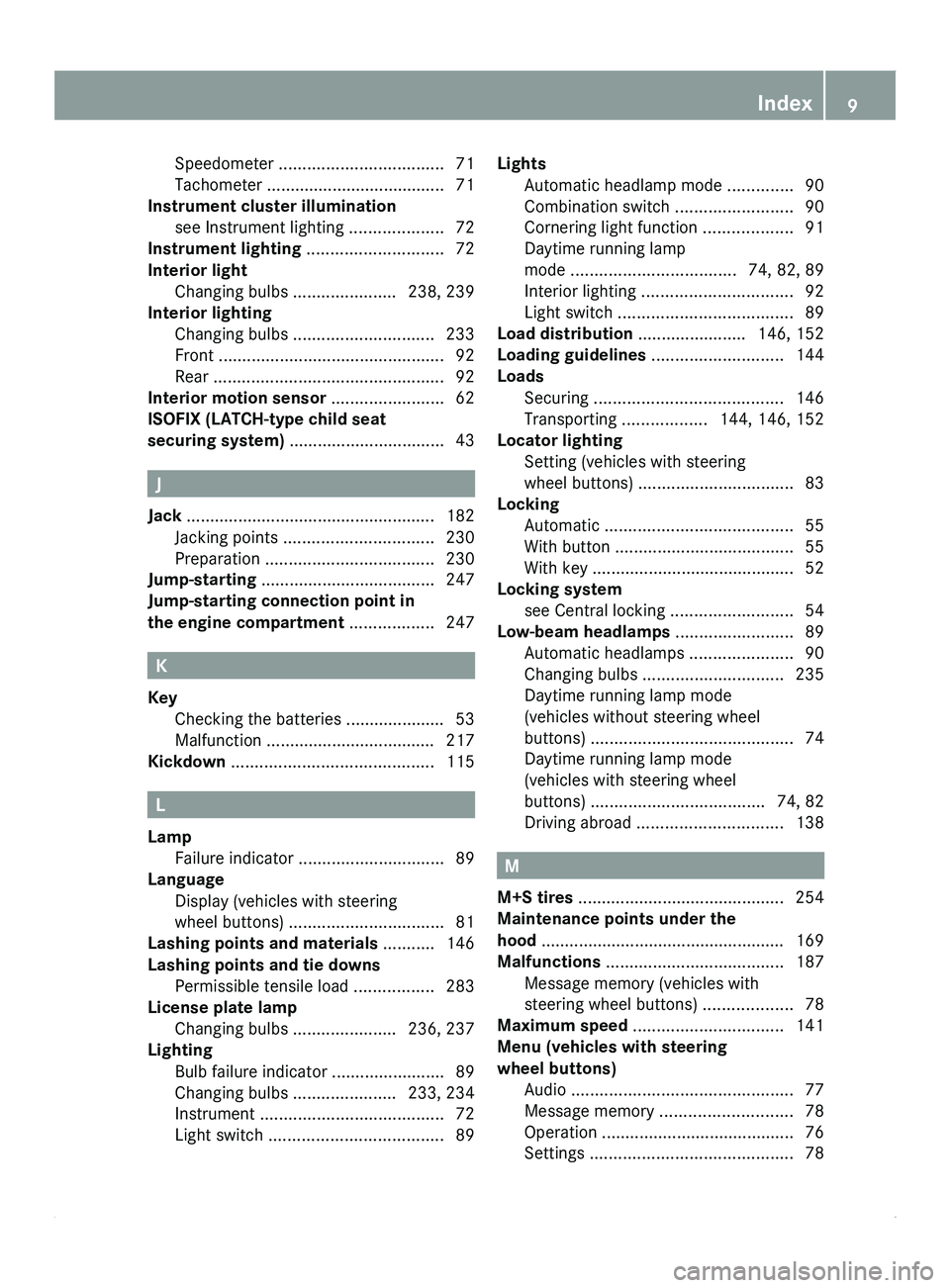
Speedometer ...................................
71
Tachometer ...................................... 71
Instrument cluster illumination
see Instrument lighting
....................72
Instrument lighting ............................. 72
Interior light Changing bulbs ......................238, 239
Interior lighting
Changing bulbs .............................. 233
Front ................................................ 92
Rear ................................................. 92
Interior motion sensor ........................62
ISOFIX (LATCH-type child seat
securing system) ................................. 43J
Jack ..................................................... 182
Jacking points ................................ 230
Preparation .................................... 230
Jump-starting ..................................... 247
Jump-starting connection point in
the engine compartment .................. 247K
Key Checking the batteries ..................... 53
Malfunction .................................... 217
Kickdown
........................................... 115L
Lamp Failure indicator ............................... 89
Language
Display (vehicles with steering
wheel buttons) ................................. 81
Lashing points and materials
...........146
Lashing points and tie downs Permissible tensile load ................. 283
License plate lamp
Changing bulbs ......................236, 237
Lighting
Bulb failure indicator ........................89
Changing bulbs ......................233, 234
Instrument ....................................... 72
Light switch ..................................... 89Lights
Automatic headlamp mode ..............90
Combination switch
.........................90
Cornering light function ...................91
Daytime running lamp
mode ................................... 74, 82, 89
Interior lighting ................................ 92
Light switch ..................................... 89
Load distribution ....................... 146, 152
Loading guidelines ............................144
Loads Securing ........................................ 146
Transporting .................. 144, 146, 152
Locator lighting
Setting (vehicles with steering
wheel buttons) ................................. 83
Locking
Automatic ........................................ 55
With button ...................................... 55
With key ........................................... 52
Locking system
see Central locking .......................... 54
Low-beam headlamps ......................... 89
Automatic headlamps ......................90
Changing bulbs .............................. 235
Daytime running lamp mode
(vehicles without steering wheel
buttons) ........................................... 74
Daytime running lamp mode
(vehicles with steering wheel
buttons) ..................................... 74, 82
Driving abroad ............................... 138 M
M+S tires ............................................ 254
Maintenance points under the
hood .................................................... 169
Malfunctions ...................................... 187
Message memory (vehicles with
steering wheel buttons)
...................78
Maximum speed ................................ 141
Menu (vehicles with steering
wheel buttons)
Audio ............................................... 77
Message memory ............................ 78
Operation ......................................... 76
Settings ........................................... 78 Index
9
Page 18 of 292
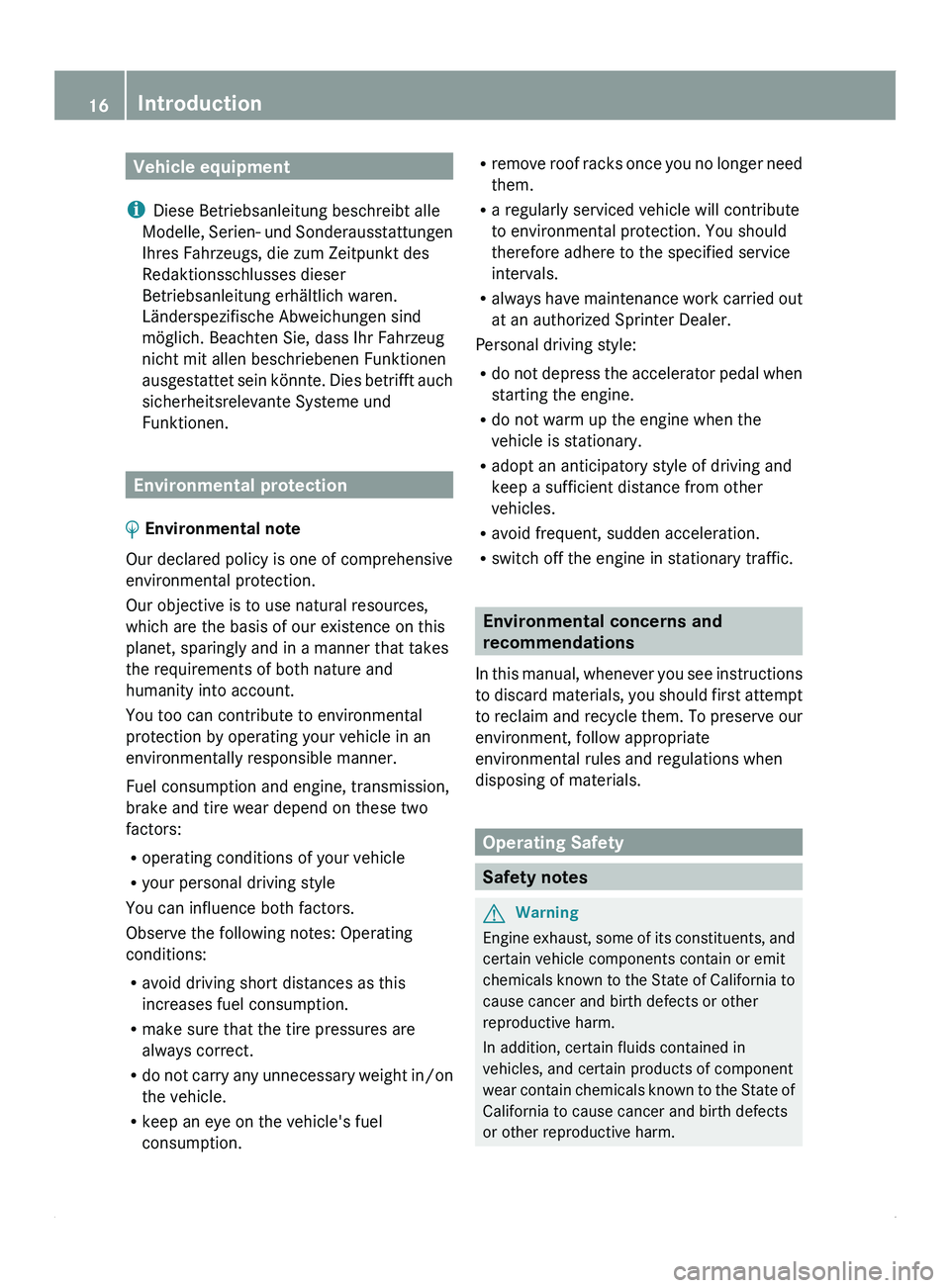
Vehicle equipment
i Diese Betriebsanleitung beschreibt alle
Modelle, Serien- und
Sonderausstattungen
Ihres Fahrzeugs, die zum Zeitpunkt des
Redaktionsschlusses dieser
Betriebsanleitung erhältlich waren.
Länderspezifische Abweichungen sind
möglich. Beachten Sie, dass Ihr Fahrzeug
nicht mit allen beschriebenen Funktionen
ausgestattet sein könnte. Dies betrifft auch
sicherheitsrelevante Systeme und
Funktionen. Environmental protection
0040
Environmental note
Our declared policy is one of comprehensive
environmental protection.
Our objective is to use natural resources,
which are the basis of our existence on this
planet, sparingly and in a manner that takes
the requirements of both nature and
humanity into account.
You too can contribute to environmental
protection by operating your vehicle in an
environmentally responsible manner.
Fuel consumption and engine, transmission,
brake and tire wear depend on these two
factors:
R operating conditions of your vehicle
R your personal driving style
You can influence both factors.
Observe the following notes: Operating
conditions:
R avoid driving short distances as this
increases fuel consumption.
R make sure that the tire pressures are
always correct.
R do not carry
any unnecessary weight in/on
the vehicle.
R keep an eye on the vehicle's fuel
consumption. R
remove roof racks
once you no longer need
them.
R a regularly serviced vehicle will contribute
to environmental protection. You should
therefore adhere to the specified service
intervals.
R always have maintenance work carried out
at an authorized Sprinter Dealer.
Personal driving style:
R do not depress the accelerator pedal when
starting the engine.
R do not warm up the engine when the
vehicle is stationary.
R adopt an anticipatory style of driving and
keep a sufficient distance from other
vehicles.
R avoid frequent, sudden acceleration.
R switch off the engine in stationary traffic. Environmental concerns and
recommendations
In this manual,
whenever you see instructions
to discard materials, you should first attempt
to reclaim and recycle them. To preserve our
environment, follow appropriate
environmental rules and regulations when
disposing of materials. Operating Safety
Safety notes
G
Warning
Engine exhaust,
some of its constituents, and
certain vehicle components contain or emit
chemicals known to
the State of California to
cause cancer and birth defects or other
reproductive harm.
In addition, certain fluids contained in
vehicles, and certain products of component
wear contain chemicals known to the State of
California to cause cancer and birth defects
or other reproductive harm. 16
Introduction
Page 19 of 292
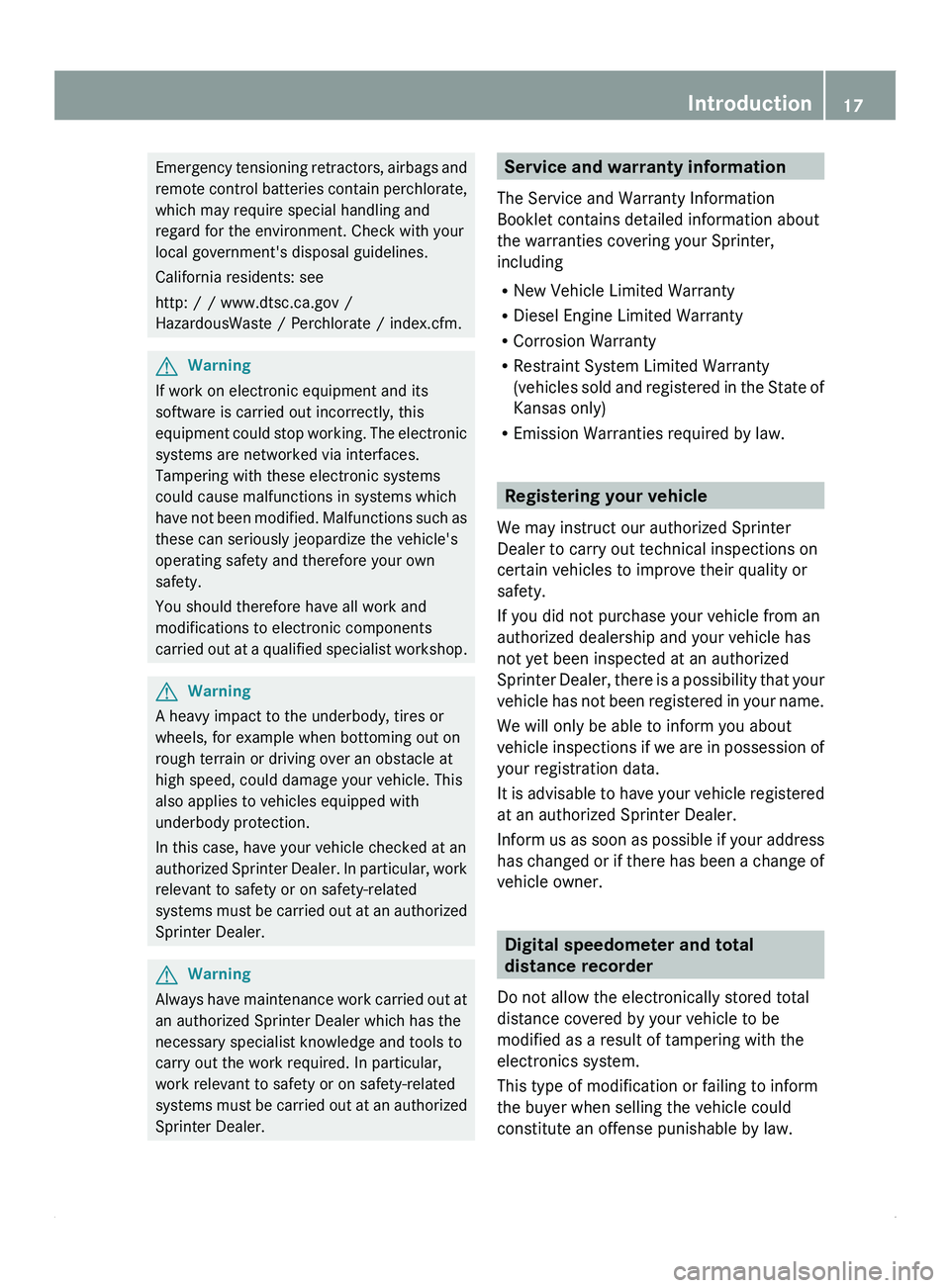
Emergency tensioning retractors, airbags and
remote control batteries
contain perchlorate,
which may require special handling and
regard for the environment. Check with your
local government's disposal guidelines.
California residents: see
http: / / www.dtsc.ca.gov /
HazardousWaste / Perchlorate / index.cfm. G
Warning
If work on electronic equipment and its
software is carried out incorrectly, this
equipment could stop
working. The electronic
systems are networked via interfaces.
Tampering with these electronic systems
could cause malfunctions in systems which
have not been modified. Malfunctions such as
these can seriously jeopardize the vehicle's
operating safety and therefore your own
safety.
You should therefore have all work and
modifications to electronic components
carried out at a qualified specialist workshop. G
Warning
A heavy impact to the underbody, tires or
wheels, for example when bottoming out on
rough terrain or driving over an obstacle at
high speed, could damage your vehicle. This
also applies to vehicles equipped with
underbody protection.
In this case, have your vehicle checked at an
authorized Sprinter Dealer.
In particular, work
relevant to safety or on safety-related
systems must be carried out at an authorized
Sprinter Dealer. G
Warning
Always have
maintenance work carried out at
an authorized Sprinter Dealer which has the
necessary specialist knowledge and tools to
carry out the work required. In particular,
work relevant to safety or on safety-related
systems must be
carried out at an authorized
Sprinter Dealer. Service and warranty information
The Service and Warranty Information
Booklet contains detailed information about
the warranties covering your Sprinter,
including
R New Vehicle Limited Warranty
R Diesel Engine Limited Warranty
R Corrosion Warranty
R Restraint System Limited Warranty
(vehicles sold and
registered in the State of
Kansas only)
R Emission Warranties required by law. Registering your vehicle
We may instruct our authorized Sprinter
Dealer to carry out technical inspections on
certain vehicles to improve their quality or
safety.
If you did not purchase your vehicle from an
authorized dealership and your vehicle has
not yet been inspected at an authorized
Sprinter Dealer, there
is a possibility that your
vehicle has not been registered in your name.
We will only be able to inform you about
vehicle inspections if we are in possession of
your registration data.
It is advisable to have your vehicle registered
at an authorized Sprinter Dealer.
Inform us as soon as possible if your address
has changed or if there has been a change of
vehicle owner. Digital speedometer and total
distance recorder
Do not allow the electronically stored total
distance covered by your vehicle to be
modified as a result of tampering with the
electronics system.
This type of modification or failing to inform
the buyer when selling the vehicle could
constitute an offense punishable by law. Introduction
17 Z
Page 72 of 292
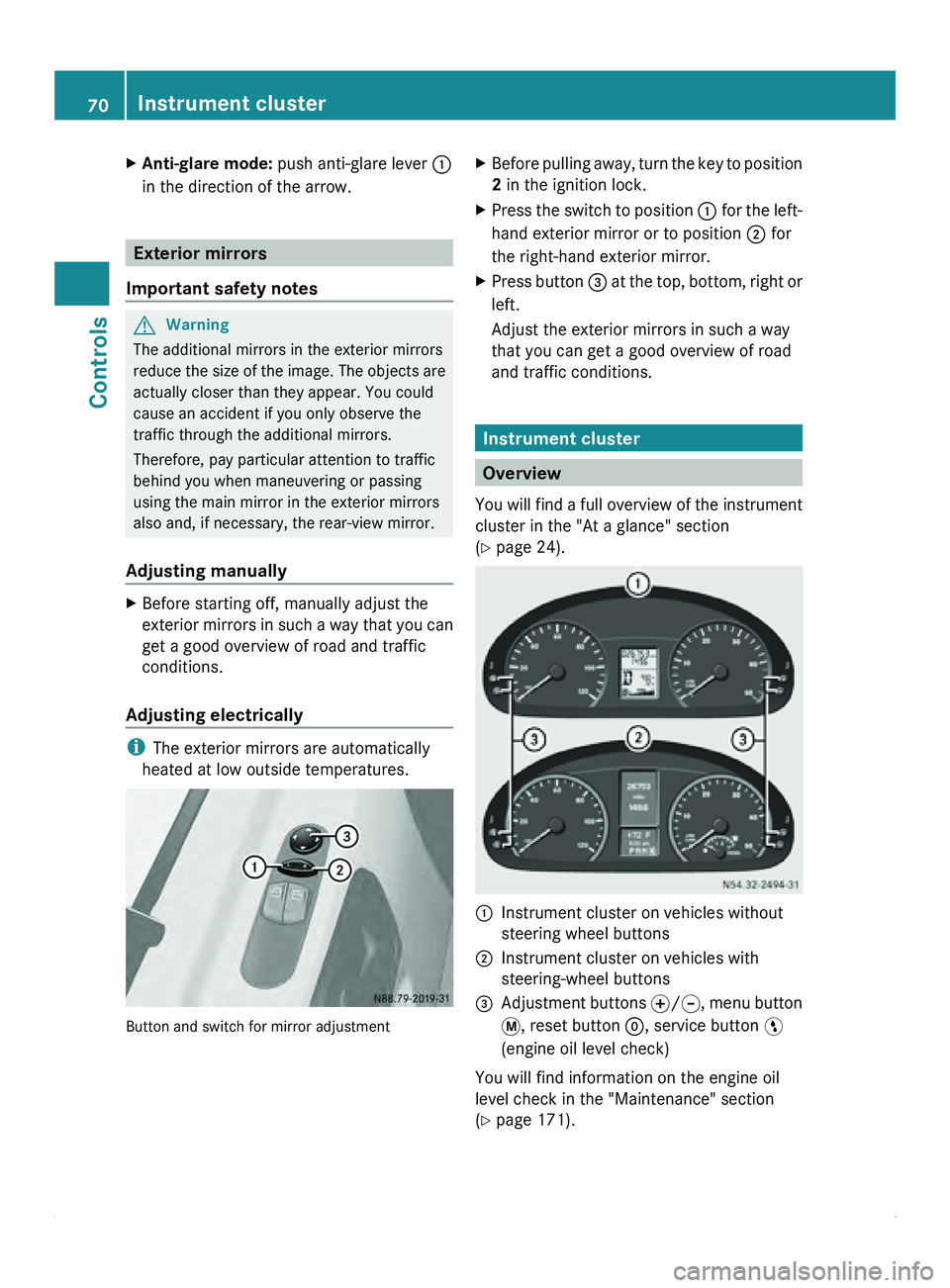
X
Anti-glare mode: push anti-glare lever 0046
in the direction of the arrow. Exterior mirrors
Important safety notes G
Warning
The additional mirrors in the exterior mirrors
reduce the size
of the image. The objects are
actually closer than they appear. You could
cause an accident if you only observe the
traffic through the additional mirrors.
Therefore, pay particular attention to traffic
behind you when maneuvering or passing
using the main mirror in the exterior mirrors
also and, if necessary, the rear-view mirror.
Adjusting manually X
Before starting off, manually adjust the
exterior mirrors in
such a way that you can
get a good overview of road and traffic
conditions.
Adjusting electrically i
The exterior mirrors are automatically
heated at low outside temperatures. Button and switch for mirror adjustment X
Before pulling away, turn the key to position
2 in the ignition lock.
X Press the switch to position 0046 for the
left-
hand exterior mirror or to position 0047 for
the right-hand exterior mirror.
X Press button 008A at
the
top, bottom, right or
left.
Adjust the exterior mirrors in such a way
that you can get a good overview of road
and traffic conditions. Instrument cluster
Overview
You will find
a full overview of the instrument
cluster in the "At a glance" section
(Y page 24). 0046
Instrument cluster on vehicles without
steering wheel buttons
0047 Instrument cluster on vehicles with
steering-wheel buttons
008A Adjustment buttons 0069/006A, menu button
007B
, reset button 0048, service button 00A4
(engine oil level check)
You will find information on the engine oil
level check in the "Maintenance" section
(Y page 171). 70
Instrument cluster
Controls
Page 100 of 292
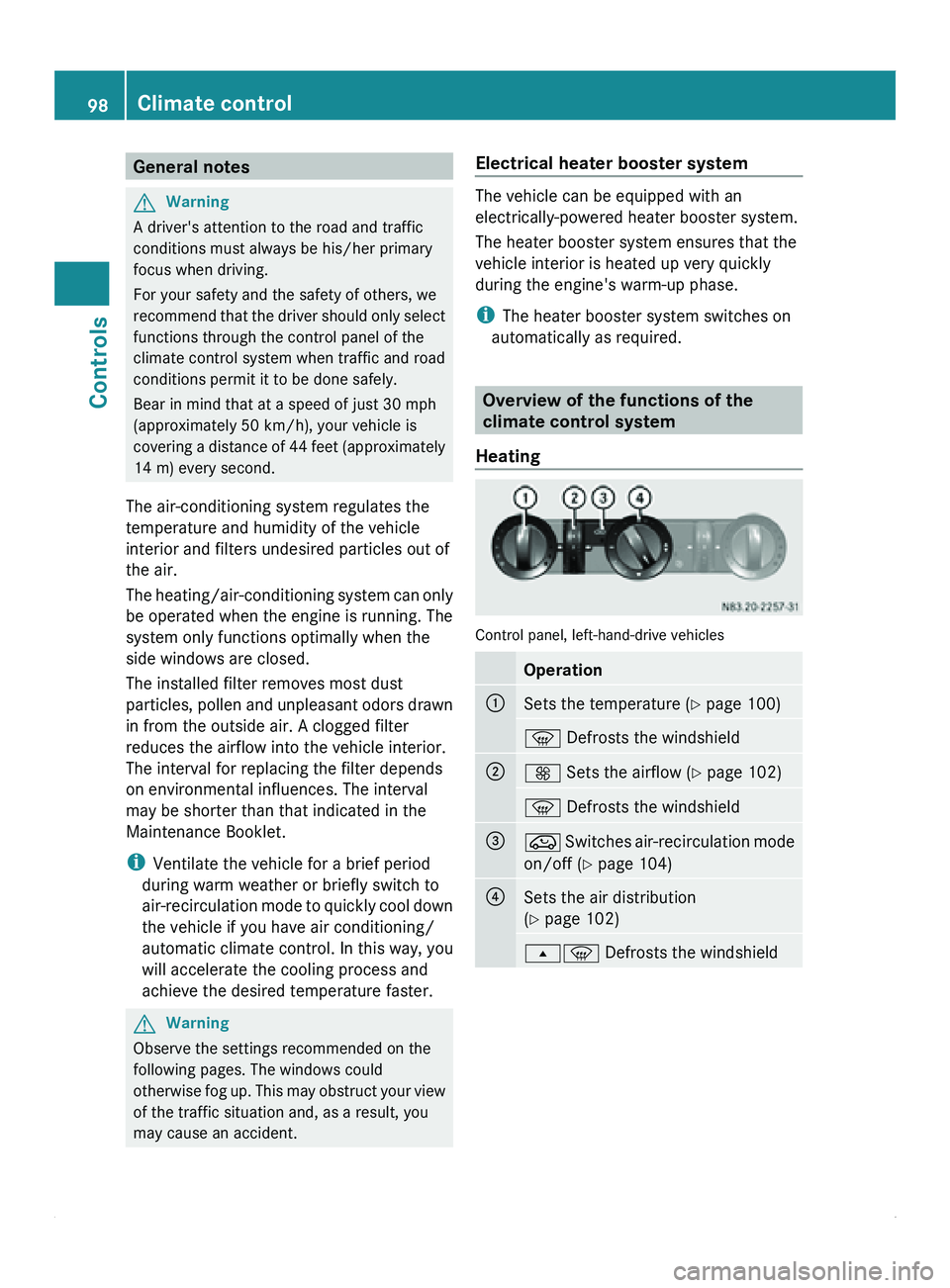
General notes
G
Warning
A driver's attention to the road and traffic
conditions must always be his/her primary
focus when driving.
For your safety and the safety of others, we
recommend that the
driver should only select
functions through the control panel of the
climate control system when traffic and road
conditions permit it to be done safely.
Bear in mind that at a speed of just 30 mph
(approximately 50 km/h), your vehicle is
covering a distance of 44 feet (approximately
14 m) every second.
The air-conditioning system regulates the
temperature and humidity of the vehicle
interior and filters undesired particles out of
the air.
The heating/air-conditioning system can only
be operated when the engine is running. The
system only functions optimally when the
side windows are closed.
The installed filter removes most dust
particles, pollen and unpleasant odors drawn
in from the outside air. A clogged filter
reduces the airflow into the vehicle interior.
The interval for replacing the filter depends
on environmental influences. The interval
may be shorter than that indicated in the
Maintenance Booklet.
i Ventilate the vehicle for a brief period
during warm weather or briefly switch to
air-recirculation mode to quickly cool down
the vehicle if you have air conditioning/
automatic climate control. In this way, you
will accelerate the cooling process and
achieve the desired temperature faster. G
Warning
Observe the settings recommended on the
following pages. The windows could
otherwise fog up.
This may obstruct your view
of the traffic situation and, as a result, you
may cause an accident. Electrical heater booster system The vehicle can be equipped with an
electrically-powered heater booster system.
The heater booster system ensures that the
vehicle interior is heated up very quickly
during the engine's warm-up phase.
i
The heater booster system switches on
automatically as required. Overview of the functions of the
climate control system
Heating Control panel, left-hand-drive vehicles
Operation
0046
Sets the temperature (
Y page 100) 0087 Defrosts the windshield
0047
0099 Sets the airflow (
Y
page 102)
0087 Defrosts the windshield
008A
008C Switches air-recirculation mode
on/off ( Y page 104) 0088
Sets the air distribution
(Y
page 102)
00800087 Defrosts the windshield98
Climate control
Controls
Page 110 of 292
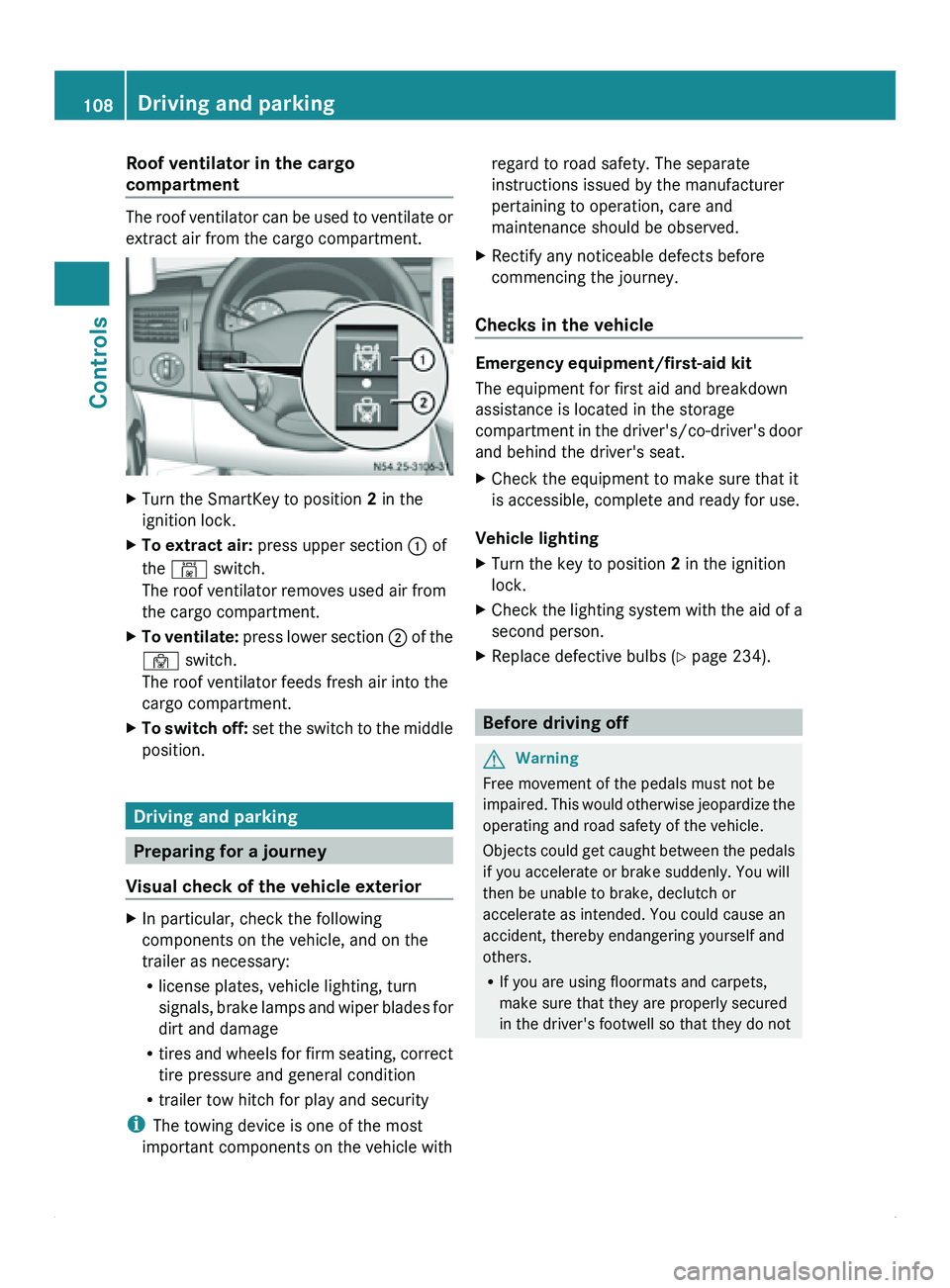
Roof ventilator in the cargo
compartment
The roof ventilator can be used to ventilate or
extract air from the cargo compartment.
X
Turn the SmartKey to position 2 in the
ignition lock.
X To extract air: press upper section 0046 of
the 00B4 switch.
The roof ventilator removes used air from
the cargo compartment.
X To ventilate: press lower section 0047 of the
00B3 switch.
The roof ventilator feeds fresh air into the
cargo compartment.
X To switch off: set the
switch to the middle
position. Driving and parking
Preparing for a journey
Visual check of the vehicle exterior X
In particular, check the following
components on the vehicle, and on the
trailer as necessary:
R
license plates, vehicle lighting, turn
signals, brake lamps
and wiper blades for
dirt and damage
R tires and wheels for firm seating, correct
tire pressure and general condition
R trailer tow hitch for play and security
i The towing device is one of the most
important components on the vehicle with regard to road safety. The separate
instructions issued by the manufacturer
pertaining to operation, care and
maintenance should be observed.
X Rectify any noticeable defects before
commencing the journey.
Checks in the vehicle Emergency equipment/first-aid kit
The equipment for first aid and breakdown
assistance is located in the storage
compartment in
the
driver's/co-driver's door
and behind the driver's seat.
X Check the equipment to make sure that it
is accessible, complete and ready for use.
Vehicle lighting
X Turn the key to position 2 in the ignition
lock.
X Check the lighting system with the aid of a
second person.
X Replace defective bulbs ( Y page 234). Before driving off
G
Warning
Free movement of the pedals must not be
impaired. This would
otherwise jeopardize the
operating and road safety of the vehicle.
Objects could get caught between the pedals
if you accelerate or brake suddenly. You will
then be unable to brake, declutch or
accelerate as intended. You could cause an
accident, thereby endangering yourself and
others.
R If you are using floormats and carpets,
make sure that they are properly secured
in the driver's footwell so that they do not108
Driving and parking
Controls
Page 139 of 292
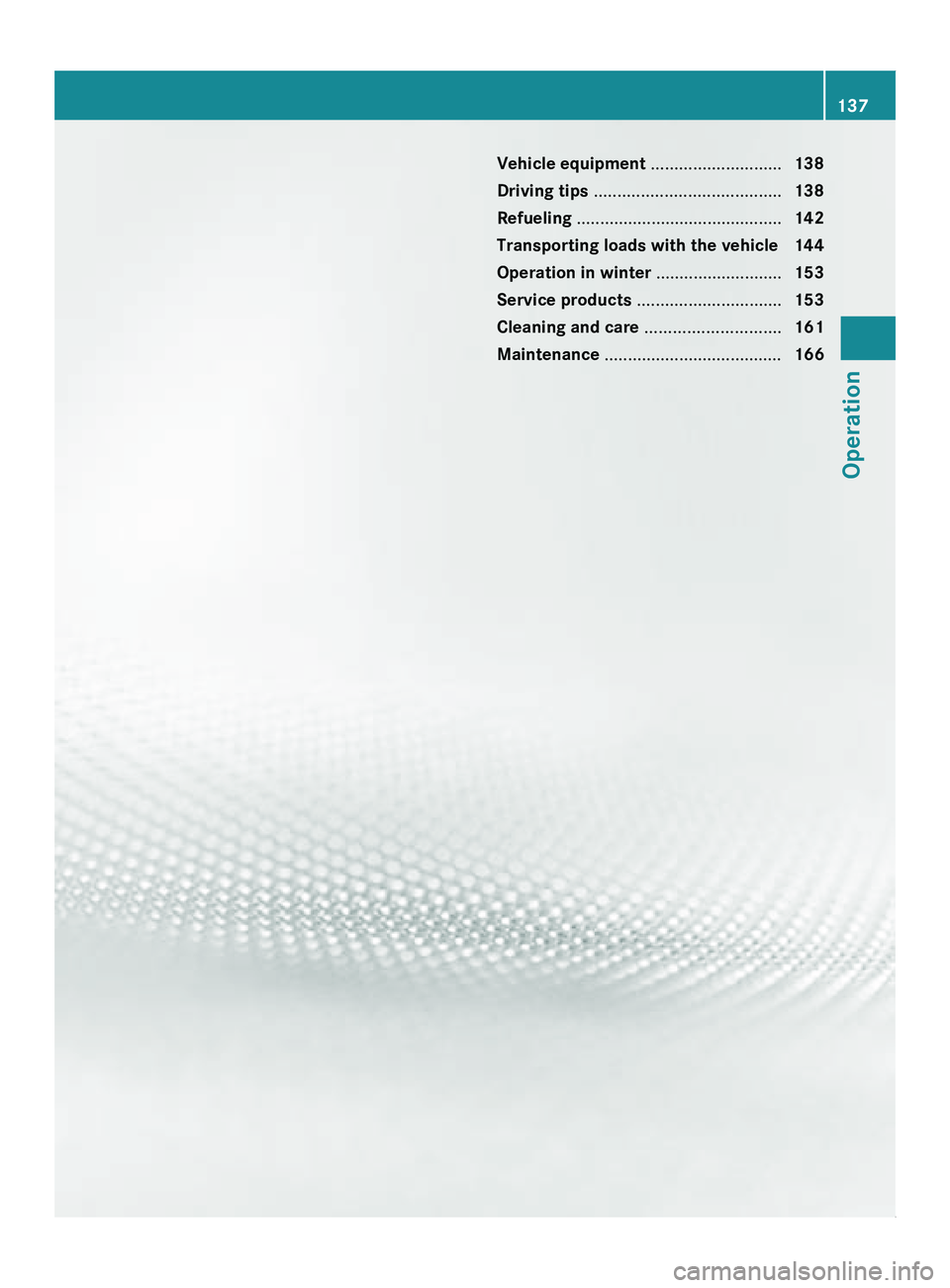
Vehicle equipment ............................
138
Driving tips ........................................ 138
Refueling ............................................ 142
Transporting loads with the vehicle 144 Operation in winter ...........................153
Service products ............................... 153
Cleaning and care ............................. 161
Maintenance ...................................... 166 137Operation
Page 143 of 292
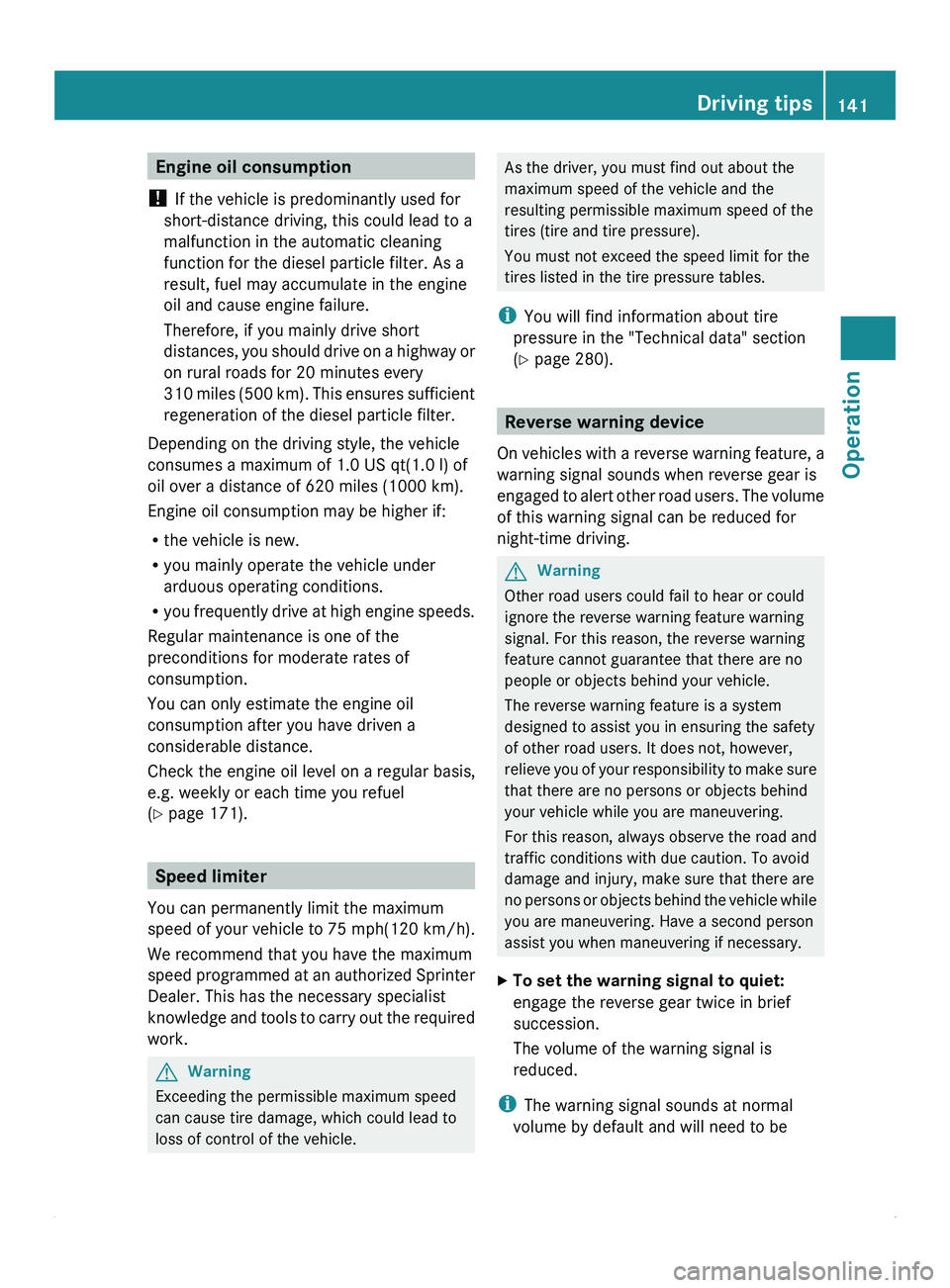
Engine oil consumption
! If the vehicle is predominantly used for
short-distance driving, this could lead to a
malfunction in the automatic cleaning
function for the diesel particle filter. As a
result, fuel may accumulate in the engine
oil and cause engine failure.
Therefore, if you mainly drive short
distances, you should
drive on a highway or
on rural roads for 20 minutes every
310 miles (500 km). This ensures sufficient
regeneration of the diesel particle filter.
Depending on the driving style, the vehicle
consumes a maximum of 1.0 US qt(1.0 l) of
oil over a distance of 620 miles (1000 km).
Engine oil consumption may be higher if:
R the vehicle is new.
R you mainly operate the vehicle under
arduous operating conditions.
R you frequently drive at high engine speeds.
Regular maintenance is one of the
preconditions for moderate rates of
consumption.
You can only estimate the engine oil
consumption after you have driven a
considerable distance.
Check the engine oil level on a regular basis,
e.g. weekly or each time you refuel
(Y page 171). Speed limiter
You can permanently limit the maximum
speed of your vehicle to 75 mph (120 km/h)
.
We recommend that you have the maximum
speed programmed at an authorized Sprinter
Dealer. This has the necessary specialist
knowledge and tools to carry out the required
work. G
Warning
Exceeding the permissible maximum speed
can cause tire damage, which could lead to
loss of control of the vehicle. As the driver, you must find out about the
maximum speed of the vehicle and the
resulting permissible maximum speed of the
tires (tire and tire pressure).
You must not exceed the speed limit for the
tires listed in the tire pressure tables.
i You will find information about tire
pressure in the "Technical data" section
(Y
page 280).
Reverse warning device
On vehicles with
a reverse warning feature, a
warning signal sounds when reverse gear is
engaged to alert other road users. The volume
of this warning signal can be reduced for
night-time driving. G
Warning
Other road users could fail to hear or could
ignore the reverse warning feature warning
signal. For this reason, the reverse warning
feature cannot guarantee that there are no
people or objects behind your vehicle.
The reverse warning feature is a system
designed to assist you in ensuring the safety
of other road users. It does not, however,
relieve you of
your responsibility to make sure
that there are no persons or objects behind
your vehicle while you are maneuvering.
For this reason, always observe the road and
traffic conditions with due caution. To avoid
damage and injury, make sure that there are
no persons or objects behind the vehicle while
you are maneuvering. Have a second person
assist you when maneuvering if necessary.
X To set the warning signal to quiet:
engage the reverse gear twice in brief
succession.
The volume of the warning signal is
reduced.
i The warning signal sounds at normal
volume by default and will need to be Driving tips
141
Operation Z
Page 152 of 292
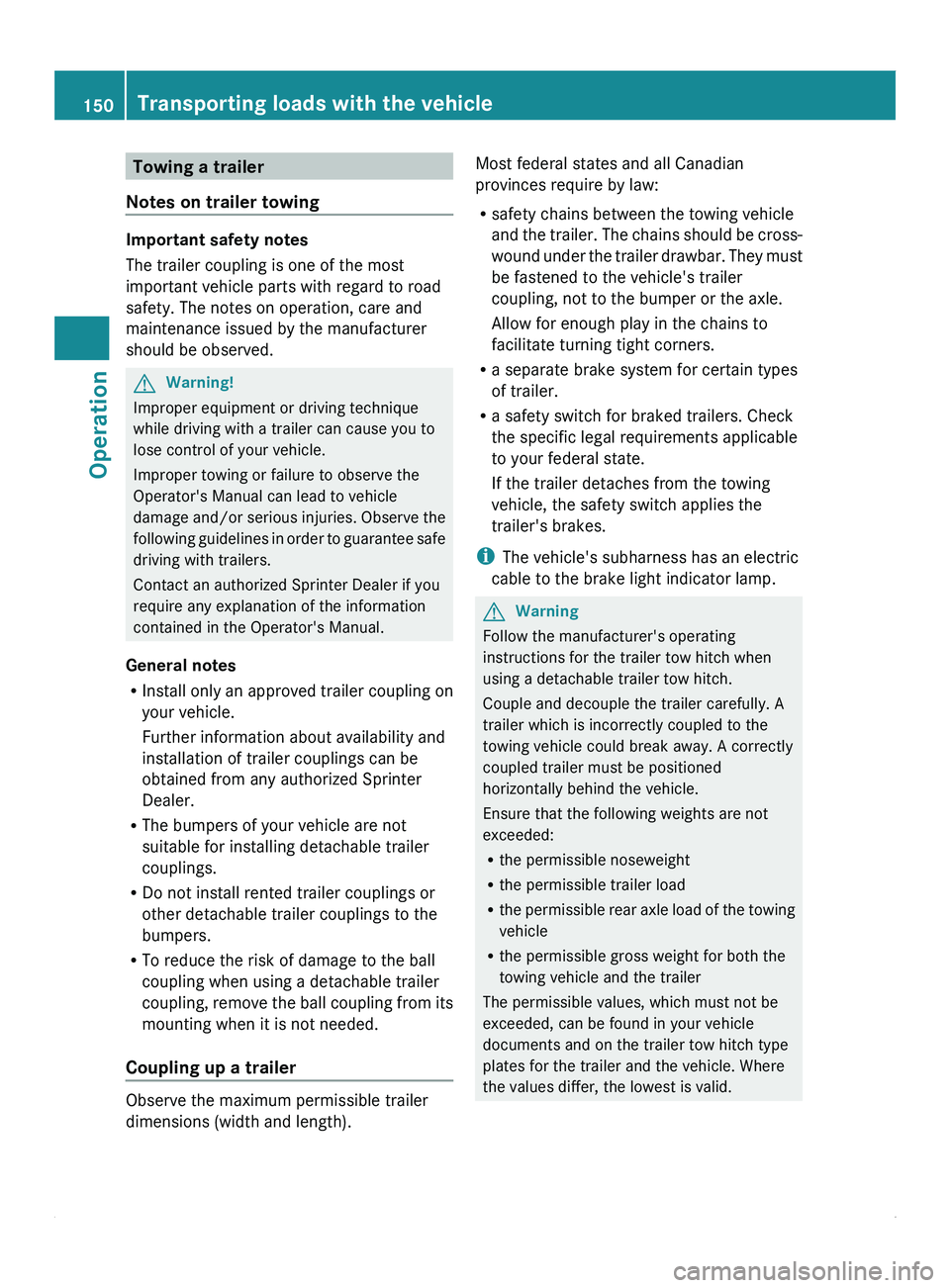
Towing a trailer
Notes on trailer towing Important safety notes
The trailer coupling is one of the most
important vehicle parts with regard to road
safety. The notes on operation, care and
maintenance issued by the manufacturer
should be observed.
G
Warning!
Improper equipment or driving technique
while driving with a trailer can cause you to
lose control of your vehicle.
Improper towing or failure to observe the
Operator's Manual can lead to vehicle
damage and/or serious
injuries. Observe the
following guidelines in order to guarantee safe
driving with trailers.
Contact an authorized Sprinter Dealer if you
require any explanation of the information
contained in the Operator's Manual.
General notes
R Install only an approved trailer coupling on
your vehicle.
Further information about availability and
installation of trailer couplings can be
obtained from any authorized Sprinter
Dealer.
R The bumpers of your vehicle are not
suitable for installing detachable trailer
couplings.
R Do not install rented trailer couplings or
other detachable trailer couplings to the
bumpers.
R To reduce the risk of damage to the ball
coupling when using a detachable trailer
coupling, remove the ball coupling from its
mounting when it is not needed.
Coupling up a trailer Observe the maximum permissible trailer
dimensions (width and length). Most federal states and all Canadian
provinces require by law:
R
safety chains between the towing vehicle
and the
trailer.
The chains should be cross-
wound under the trailer drawbar. They must
be fastened to the vehicle's trailer
coupling, not to the bumper or the axle.
Allow for enough play in the chains to
facilitate turning tight corners.
R a separate brake system for certain types
of trailer.
R a safety switch for braked trailers. Check
the specific legal requirements applicable
to your federal state.
If the trailer detaches from the towing
vehicle, the safety switch applies the
trailer's brakes.
i The vehicle's subharness has an electric
cable to the brake light indicator lamp. G
Warning
Follow the manufacturer's operating
instructions for the trailer tow hitch when
using a detachable trailer tow hitch.
Couple and decouple the trailer carefully. A
trailer which is incorrectly coupled to the
towing vehicle could break away. A correctly
coupled trailer must be positioned
horizontally behind the vehicle.
Ensure that the following weights are not
exceeded:
R the permissible noseweight
R the permissible trailer load
R the permissible rear
axle load of the towing
vehicle
R the permissible gross weight for both the
towing vehicle and the trailer
The permissible values, which must not be
exceeded, can be found in your vehicle
documents and on the trailer tow hitch type
plates for the trailer and the vehicle. Where
the values differ, the lowest is valid. 150
Transporting loads with the vehicle
Operation